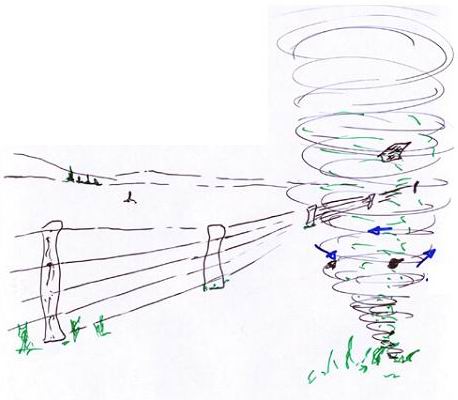
The science of Micrometeorology draws most directly on Mathematics and Physics. Of course many other disciplines also play a vital role (Chemistry, Instrumentation...).
When air flows in a plane-parallel (or laminar) fashion, with adjacent layers slipping one over the other, slower moving layers retard faster-moving layers only by viscous friction (according to Newton's law of viscosity, momentum is passed down the velocity gradient from fast-moving layers to slow-moving layers). However, any cross-stream exchange of mass, i.e., the movement of air parcels out of slow-moving layers into faster layers and vice versa, leads to a dramatic increase in the rate of momentum transfer; a fast moving parcel descending into a sluggish layer gives up its excess momentum to the surrounding environment - momentum exchange.
Now except in special cases, (eg. flow over mountains), we can regard cross stream exchange as being synonomous with fluctuating vertical motion, i.e., with turbulence. Turbulence is dissipative, and unless energy is supplied to sustain turbulent motion, turbulence cannot exist. The conditions making possible a supply of energy to turbulence (and therefore rapid vertical mixing) are wind shear (spatial gradients in average windspeed) and unstable buoyancy forces (warm air underlying cold). It follows that we expect to see strong vertical mixing, primarily near the ground, where the no-slip condition requires the velocity to vanish (hence, a strong wind shear exists above the surface) and where the daily release of radiant energy supplies heat, leading to buoyant enhancement of mixing (turbulence).
This layer of air adjacent to the ground within which there is convective vertical exchange (i.e., turbulent vertical velocities facilitating vertical exchange of mass, energy, and momentum) is termed the "mixing layer" or the "Planetary Boundary-Layer" (PBL). Outside the PBL vertical exchange is very slow. Direct consequences of the lack of exchange between the PBL and the higher atmosphere are
It turns out that the typical magnitude of these vertical velocities (often specified by a vertical velocity standard deviation sw) is relatively height- independent in the PBL except in a thin layer imnmediately against the surface across which it drops to zero. On the other hand, the typical timescales of these fluctuations are very small near the ground and increase roughly in proportion with distance away from the ground (for the time being we could regard the "timescale" as being a typical elapsed time between reversals of the sign of the vertical velocity). This may be summed up by the statement that "eddy size increases with distance away from the ground." Somewhere in the mid-PBL the eddy size reaches a maximum value and above that level may decrease or remain constant.
The "eddy size" in the vertical (used in a qualitative sense - we must not imagine perfect circles of motion) is closely related to the efficiency of the vertical exchange process. In fact, we often quantify the efficiency of vertical exchange by introducing an "exchange coefficient" (K), which in line with the above arguments vanishes at ground (z = 0) and increases in proportion to distance above ground, over a considerable depth.
Now it is possible to introduce the "Atmospheric Surface Layer" (ASL), the layer of the atmosphere within which all our activities (except flying) take place. The ASL is the inner layer of the PBL within which vertical mixing is limited by proximity to the ground - a layer within which the eddy size is small because the solid barrier prohibits any organized downward (or upward) motion. Vast amounts of heat and vapour travel through this surface layer to the outer PBL and ultimately the whole atmosphere. How can this be if the vertical mixing is limited? The simple answer is, that the vertical gradients in temperature and humidity adjust themselves so that the weak mixing, operating on a very strong spatial gradient, brings about the required rate of removal of heat and moisture. Taking this to extremes, in the thin viscous boundary layer on a smooth surface (say, a flat desert) vertical heat transfer occurs entirely by molecular conduction. Calculated temperature gradients needed to remove the energy released at the ground (z = 0) are of order 10,000 C/m (these strong gradients exist over only minute distances). Correspondingly, the strong gradients of temperature, humidity, and windspeed in the ASL weaken with increasing height, and outside the ASL it is common to speak of a "mixed layer" within which the gradients are very small.
It is now helpful to describe the outer PBL or "Mixed Layer" as a "reservoir". A reservoir is a "store" from which we can draw large quantities but have negligible impact on the "level" in storage. Daily, heat is added to and drawn from this reservoir through a "valve", the ASL, to the site of gain (daytime radiative heating) and loss (night-time radiative cooling). Likewise the ASL is a value which controls the extent to which we are forced to breathe the air contaminated by our own emissions, as opposed to breathing the relatively clean air which results from the strong dilution brought about by rapid mixing of the pollutants with the reservoir.
How does study of turbulence and diffusion in context of meteorology differ from engineering context?